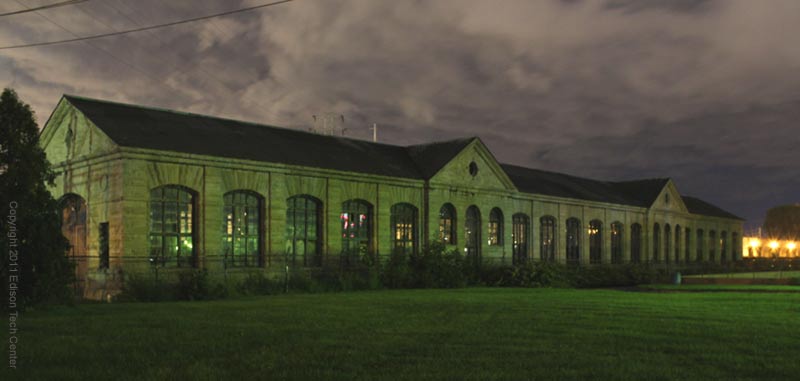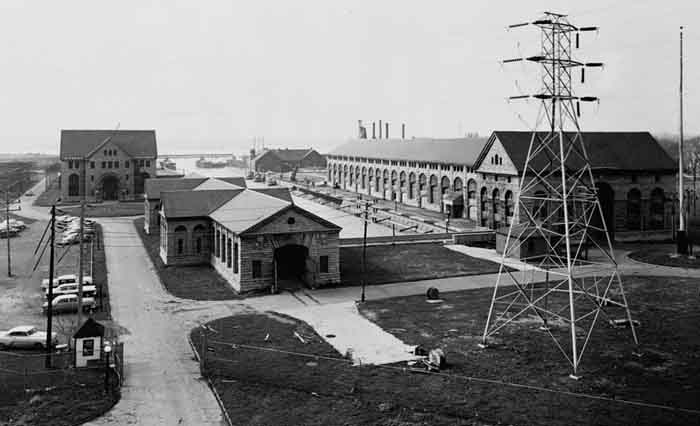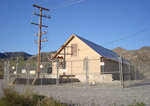
Harnessing
Niagara Falls:
The Adams Power Station
The most famous of early hydroelectric power stations

People have been
inspired to tap the power of Niagara for industrial use before the advent
of electric power.
This is perhaps the most famous historical power station in the world. The current fame is due to the long lasting effects of Westinghouse publicity machine, the fact that it is located at "the" Niagara Falls, and the connection to the internet demagoguery surrounding Nikola Tesla.
The Edward Dean Adams Power Station built in 1895 was not the first hydro power station at Niagara, but it goes down in history as being the largest hydro electric power generation site of it's era. Also: we have listed other smaller power plants at Niagara which predated the "Adams" on our timeline lower on this page.
The Adam's site consisted of several buildings just southeast of Niagara Falls itself. The generators were the showpiece of Westinghouse's engineering capabilities. The power transmission contract was won by General Electric which had already done a few other projects of similar transmission distance. Power was sent 25 miles to the booming industrial city of Buffalo, New York. The Adams power station was accompanied by an enormous worldwide publicity campaign. This long lasting publicity is part of the reason why many falsely believe the Niagara Falls power plant was the first AC hydro power plant. AC hydro electric power goes back to the 1870s in the Austro-Hungarian Empire. The Adams Power Station stands as a monument to the first large scale application of AC power in North America.
The transformer house. The last remaining building from the Adams Power Station. The main powerhouse was demolished in 1961.
The facility before most of it was demolished. The transformer house is seen center-left.
About this Power Generation Site:
Notable features: Largest power station ever built until 1895. Attracted national attention due to the enormous size of the project, and collaboration of both electric giants of the continent: GE and Westinghouse contributed to the publicity engine.
Frequency: 25 Hz
Two-Phase, Alternating Current
Power Transmission Length: 25 miles at 11,000 volts using #1 wire
Power system built by: Westinghouse
Notable Engineers:
Thomas Evershed
Cataract Company: George Forbes
Westinghouse: Benjamin G. Lamme, Oliver Shallenberger, Nikola Tesla
General Electric: William Stanley, Dr. Louis Bell, Charles P. Steinmetz
Maximum Power Output: 37 Megawatts: 50,000 horsepower (1896)
MORE on the ENGINEERS:
Thomas Evershed - water power engineer, naturalist, and artist- worked for the State of New York on the Erie Canal. Niagara Falls was his last big project at age 69. He is responsible for preserving the aesthetics of Niagara Falls today. He designed the power station to not interfere with the natural beauty of Goat Island and tourist development areas of the American side.
Benjamin G. Lamme - The principal electrical engineer who built and improved generator designs from Tesla. Lamme is arguably Westinghouse's greatest pioneer. Lamme designed practical and reliable designs of all sorts of apparatus including generators, motors, rotary converters. Today we use Lamme's induction motor design, not Tesla's. This genius remained loyal to Westinghouse and was awarded many honors in his lifetime. Today he is unfortunately unknown. Read more about him here.
Oliver Shallenberger - Was an early pioneer of AC power before Tesla and Lamme at Westinghouse. Shallenberger was involved in the Great Barrington experiment with William Stanley. They pioneered transformer design. By 1895 Shallenberger was working with Westinghouse as an independent contractor. His early contributions in the 1880s were an important foundation for more sophisticated work in the 1890s. More on Shallenberger
Nikola Tesla - The Adams plant was based on Tesla's 25 Hz AC power system. The Tesla Society falsely states: "Nikola Tesla and George Westinghouse built the first hydroelectric power plant in 1895 in Niagara Falls and started the electrification of the world".
This internet myth has gained enormous strength. It is well documented that efforts at Niagara Falls were a result of a larger team. Strangely Westinghouse himself had suggested transporting power to Buffalo using compressed air in 1890 despite past successes in experimental AC systems. Another testament to the need for teamwork was the fact that Tesla's initial generator designs for Niagara were burning up on test, it took Lamme and his team to fix the design and make the generators usable. C.P. Steinmetz working as independent contractor was also involved in fixing this thermal/electrical issue. Interestingly Steinmetz had worked on General Electric's competing 3 phase bid ($1 million) to get the power generation contract at Niagara. Westinghouse won the bid by undercutting GE by $ 601,000. What followed was a great experiment to make a working large scale 25 Hz system! Read more
TIMELINE: Important Dates for NIAGARA FALLS:
1880s - Other small scale DC hydro power operations existed at Niagara Falls, none compare to the scale of Evershed's plans, but the idea of putting a large scale power plant at the site is widespread.1886 - In nearby Buffalo, New York the first commercial AC power system in the USA is built. This system designed by George Westinghouse, William Stanley, and Oliver B. Shallenberger
1886 - Thomas Evershed develops a plan to use massive underground tunnels and a powerhouse to capture the power of the Niagara River at the falls.
1892 - George Forbes decides to use an alternating current system instead of direct current. AC power had proven itself the best system for power transmission the year before at the Electro-Technical Exposition at Frankfurt, Germany.
1892 - Construction started on a 21 ft. high 18 ft. wide tunnel to capture Niagara waters for the power plant. The tunnel took 3 years to build and cost 28 lives
1893 - Final bids were presented by GE and Westinghouse for the generators. The Cataract Company chose 2 phase instead of GE's 3 phase system. Westinghouse proposed 30 and 60 Hz systems. General Electric proposed 41.66 Hz. President Adams and Forbes of the Cataract Co. chose Westinghouse's system, thinking that two phase would work better for the anticipated single phase distribution to homes.
1895 - Powerhouse #1 began producing power. Consisted of 5000 hp, 25 Hz, two-phase, four-wire generators.
1896 - November 15th the City of Buffalo first receives power from the falls from a 25 mile transmission line
Further Reading:
We recommend you visit the various well made sites about the famous 1895 Niagara Falls electric power efforts.
http://ublib.buffalo.edu/libraries/projects/cases/niagara.htm/
Sources:
IEEE - Early Electrification of Buffalo: Adams Station - Electric Development
Niagara Falls History of Power - www.niagarafrontier.com
Adams Power Plant Transformer House - WikipediaPhotos
M. Whelan
Library of Congress
Other early power plant links:
|
Mechanicville Power Station, Mechanicville, New York 1897 |
|
|
Schaghticoke Power Station and Steinmetz's monocyclic power experiment |
Great Barrington 1886 The first AC power distribution system using transformers |
Photo/Video
use:
Commercial entities must pay for use of photos/graphics/videos in their
web pages/videos/publications
No one commercial or public is allow to alter Edison Tech Center photos/graphics/videos.
Educational Use: Students and teachers may use photos and videos
for school. Graphics and photos must retain the Edison Tech Center watermark
or captions and remain unmanipulated except for sizing.
Permissions
- Videos: We do not email, FTP, or send videos/graphics to anyone
except in DVD form. Payment is needed for this service. See our donate
page for pricing, and our catalogue
for a listing of videos on DVD.
Professional video production companies may get videos in data form with
signed license agreements and payment at commercial rates.
Copyright 2013 Edison Tech Center







